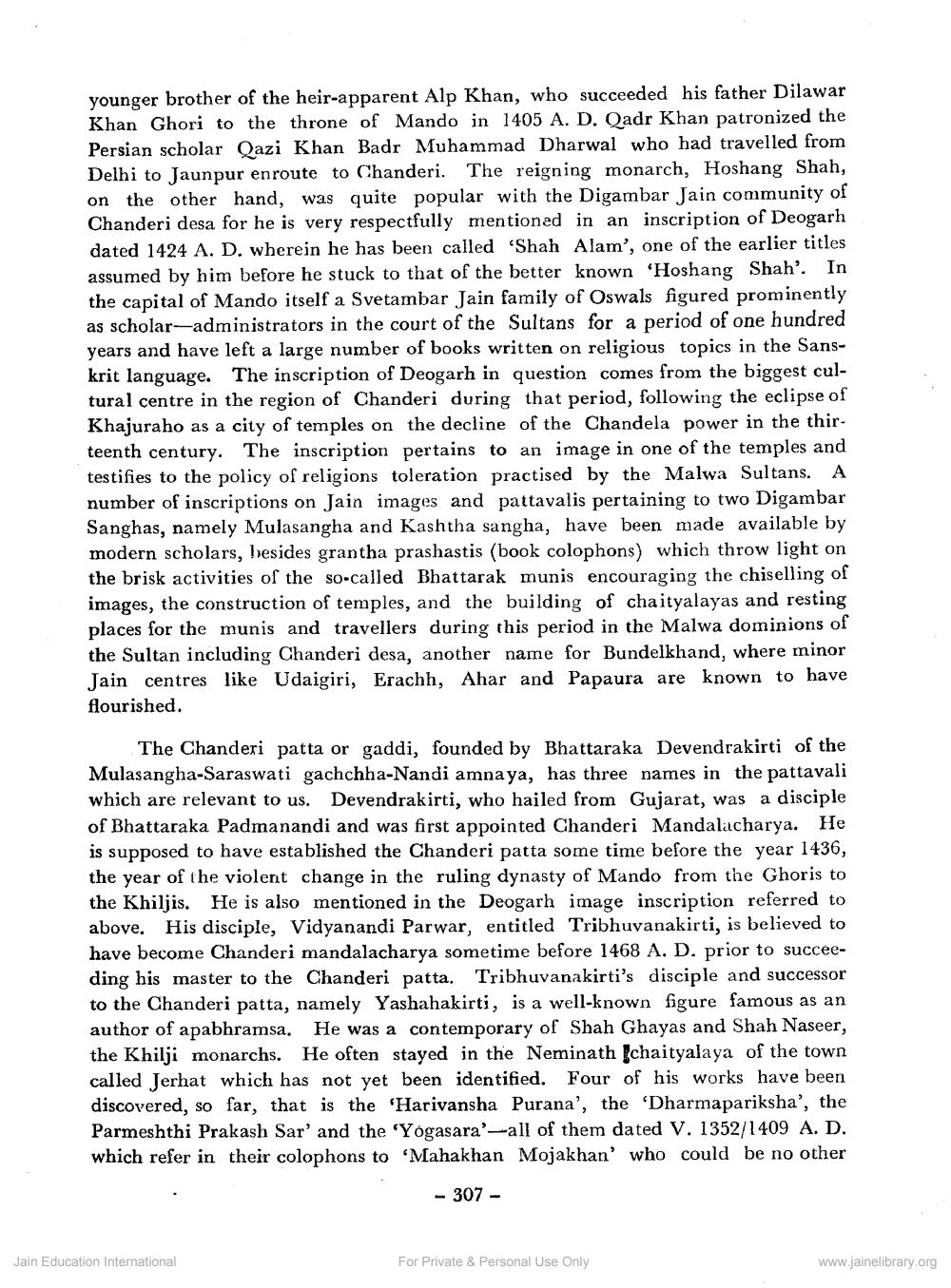Book Title: Chanderi Under Malva Sultansa Author(s): H A Nijamji Publisher: Z_Kailashchandra_Shastri_Abhinandan_Granth_012048.pdf View full book textPage 4
________________ younger brother of the heir-apparent Alp Khan, who succeeded his father Dilawar Khan Ghori to the throne of Mando in 1405 A. D. Qadr Khan patronized the Persian scholar Qazi Khan Badr Muhammad Dharwal who had travelled from Delhi to Jaunpur enroute to Chanderi. The reigning monarch, Hoshang Shah, on the other hand, was quite popular with the Digambar Jain community of Chanderi desa for he is very respectfully mentioned in an inscription of Deogarh dated 1424 A. D. wherein he has been called "Shah Alam', one of the earlier titles assumed by him before he stuck to that of the better known 'Hoshang Shah'. In the capital of Mando itself a Svetambar Jain family of Oswals figured prominently as scholar-administrators in the court of the Sultans for a period of one hundred years and have left a large number of books written on religious topics in the Sanskrit language. The inscription of Deogarh in question comes from the biggest cultural centre in the region of Chanderi during that period, following the eclipse of Khajuraho as a city of temples on the decline of the Chandela power in the thirteenth century. The inscription pertains to an image in one of the temples and testifies to the policy of religions toleration practised by the Malwa Sultans. A number of inscriptions on Jain images and pattavalis pertaining to two Digambar Sanghas, namely Mulasangha and Kashtha sangha, have been made available by modern scholars, besides grantha prashastis (book colophons) which throw light on the brisk activities of the so-called Bhattarak munis encouraging the chiselling of images, the construction of temples, and the building of chaityalayas and resting places for the munis and travellers during this period in the Malwa dominions of the Sultan including Chanderi desa, another name for Bundelkhand, where minor Jain centres like Udaigiri, Erachh, Ahar and Papaura are known to have flourished. The Chanderi patta or gaddi, founded by Bhattaraka Devendrakirti of the Mulasangha-Saraswati gachchha-Nandi amnaya, has three names in the pattavali which are relevant to us. Devendrakirti, who hailed from Gujarat, was a disciple of Bhattaraka Padmanandi and was first appointed Chanderi Mandalacharya. He is supposed to have established the Chanderi patta some time before the year 1436, the year of the violent change in the ruling dynasty of Mando from the Ghoris to the Khiljis. He is also mentioned in the Deogarh image inscription referred to above. His disciple, Vidyanandi Parwar, entitled Tribhuvanakirti, is believed to have become Chanderi mandalacharya sometime before 1468 A. D. prior to succeeding his master to the Chanderi patta. Tribhuvanakirti's disciple and successor to the Chanderi patta, namely Yashahakirti, is a well-known figure famous as an author of apabhramsa. He was a contemporary of Shah Ghayas and Shah Naseer, the Khilji monarchs. He often stayed in the Neminath chaityalaya of the town called Jerhat which has not yet been identified. Four of his works have been discovered, so far, that is the 'Harivansha Purana', the 'Dharmapariksha', the Parmeshthi Prakash Sar' and the 'Yogasara'-all of them dated V. 1352/1409 A. D. which refer in their colophons to 'Mahakhan Mojakhan' who could be no other - 307 - Jain Education International For Private & Personal Use Only www.jainelibrary.orgPage Navigation
1 2 3 4 5 6 7 8
